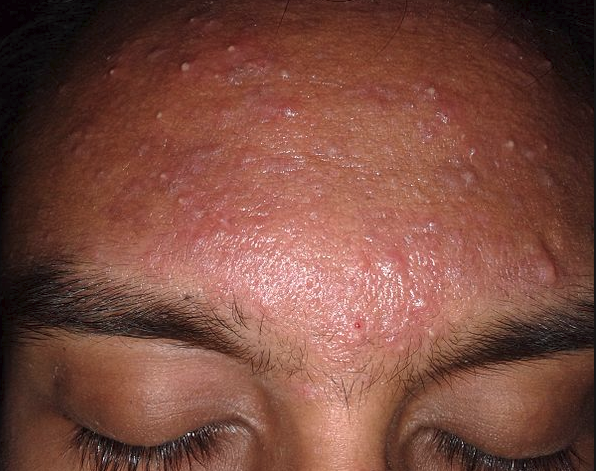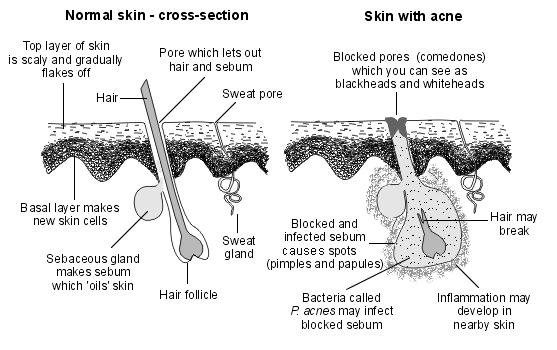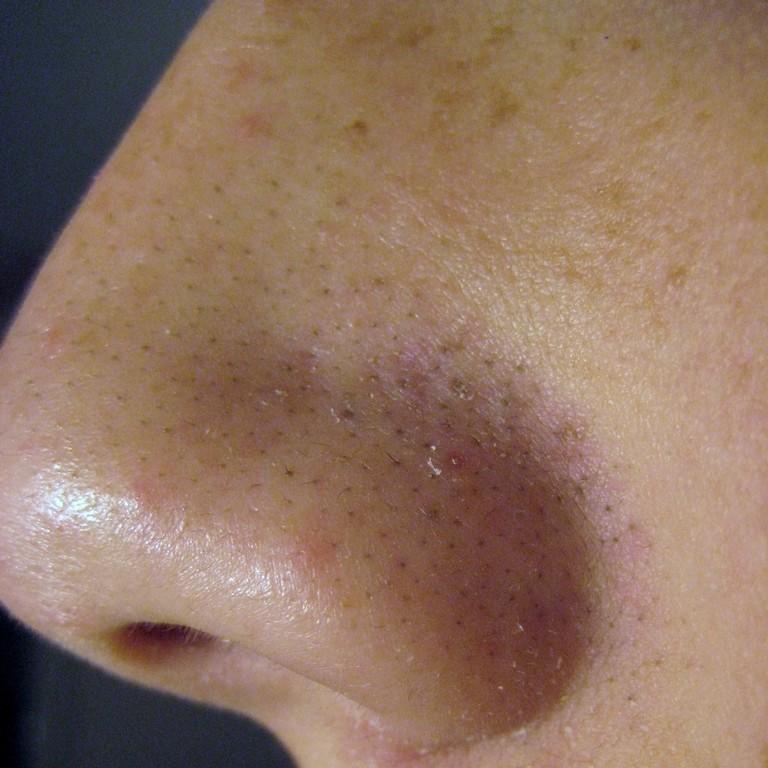Acne
Peer reviewed by Dr Hayley Willacy, FRCGP Last updated by Dr Colin Tidy, MRCGPLast updated 20 Nov 2023
Meets Patient’s editorial guidelines
- DownloadDownload
- Share
- Language
- Discussion
In this series:Acne treatments
Acne (also called 'zits', spots or pimples) is a common condition, particularly in teenagers. It can also occasionally affect middle-aged people and babies.
It often causes a lot of worry and distress but can usually be cleared up, or at least improved a lot, with the right treatment. The treatment can take about a month to work and may need to continue for a while, even after the spots have cleared.
In this article:
Continue reading below
What is acne?
Acne is a common skin condition that causes black, white or red spots, usually on the face. It can also affect other areas of skin such as the back and the top of the chest.
Sebaceous glands are tiny glands found near the surface of skin. The glands are attached to hair follicles in skin. Sebaceous glands stop skin and hair from drying out by producing an oily substance called sebum.
In acne, the glands produce too much sebum, which can form a plug in the follicle (causing blackheads and whiteheads). The normal and otherwise harmless skin bacteria can then infect the plugged follicles, causing papules, pustules, nodules or cysts.
How common is acne?
Most people with acne are aged between 12 and 25 years but some older people are affected. Boys are more commonly affected than girls. Acne usually affects the face but may also affect the back, neck and chest.
About 8 in 10 teenagers develop some form of acne. Often it is mild depending on the type of acne. However, it is estimated that about 3 in 10 teenagers have severe acne bad enough to need treatment to prevent scarring. Untreated acne usually lasts about 4-5 years before settling by itself.
Continue reading below
What are the symptoms of acne?
There are six main types of spot that are caused by acne:
Blackheads, which are small and either black or yellowish.
Whiteheads are similar in appearance to blackheads, but tend to be firmer and do not empty when squeezed.
Papules are small and red, and may feel tender or sore.
Pustules are similar to papules, but with a white tip that is caused by pus.
Nodules are large hard, often painful, lumps beneath the skin.
Cysts are large pus-filled lumps that look similar to boils. They are the most severe type of acne, with the greatest risk of permanent scarring.
What does acne look like?
This shows typical, mild acne on the forehead that almost all teenagers will get at some point. This usually fades with time, or responds well to a simple cream like benzoyl peroxide
Forehead acne (mild)

By Roshu Bangal (Own work) via Wikimedia Commons
Continue reading below
What are the different types of acne?
The common type of acne discussed in this leaflet is sometimes called acne vulgaris. There are other less common types of acne.
Acne (vulgaris) can be divided by severity into:
Mild acne: mostly non-inflamed lesions (whitehead and blackheads).
Moderate acne: more widespread with more papules and pustules.
Severe acne: widespread papules, pustules and nodules or cysts, often with scarring.
Acne fulminans is a very rare, severe form of acne that almost always affects young, white males. It causes many painful nodules and/or cysts, and affects large areas of the skin. The nodules and cysts fill with blood and often cause severe scarring. Acne fulminans can also cause fever, tiredness, and muscle pain.
What causes acne?
This picture shows a tiny hair follicle and a tiny sweat pore (a 'pore' is just a tiny hole in the skin). The left half of the picture shows a normal hair follicle and pore: they are open, unblocked and working properly.
At the bottom of the shaft of hair a small circle called a 'sebaceous gland' which makes the usual oil that we all have on our skin. The right half of the picture shows what happens if the hair follicle becomes blocked: the oil can't come out on to the skin and so the bottom section of the hair bulges up, full of oil (or what is technically called sebum).
Normal skin and acne skin

This bulge under the skin causes a spot (or 'zit'). Tiny bugs, or bacteria, can then grow inside the blocked hair follicle and make the spot go red and sore.
So the two things that cause acne are:
a) A clogged pore or hair follicle; and/or
b) Infection at the bottom of the blockage.
The treatments for acne aim to:
a) Unblock the pores or hair follicles on skin; and/or
b) Kill any infection inside.
This photo shows blackheads on someone's nose. Blackheads are a blocked pore, with dead skin cells gathered up inside. Despite popular belief, the black bit is not dirt: it's dead skin cells gathered up, made to look dark by the pigment in skin, called melanin.
Acne blackheads

By Elecbullet (Own work) via Wikimedia Commons
Can anything else cause acne?
The description above is the cause of almost all cases of acne. Rarely, acne in women can be caused or made worse by certain medical conditions. For example, polycystic ovary syndrome and conditions that cause excess male hormone to be made in the ovary or adrenal gland.
These conditions cause other symptoms in addition to acne, such as thinning of scalp hair, excess hair growth (hirsutism) of facial or body hair, and other problems. Being exposed to chemicals in the workplace, particularly things called halogenated hydrocarbons, can cause acne.
A condition called rosacea, which affects about 1 in 10 people in the UK, can also lead to small cysts and lumpy spots that look like acne. As with acne, rosacea mostly affects the face (although chest, neck and ears can sometimes be affected too). However, rosacea tends to start in middle age and causes other symptoms, such as flushing or redness of the face.
Occasionally acne can be a side effect of treatment with medicines including oral contraception, corticosteroids, anti-epilepsy medicine and lithium.
How to get rid of acne
Avoid over-cleaning the skin as this may cause dryness and irritation.
Use a non-alkaline synthetic detergent cleansing product twice daily.
Avoid oil-based skincare products, make-up and sunscreens. Remove any make-up at the end of each day.
Avoid picking, pinching or scratching the spots as this can increase the risk of scarring.
Avoid sugar and sugary food and drinks. Maintain a healthy diet.
See also the leaflet on Acne Treatments, for more information on treatments that can be used for acne, such as taking an oral antibiotic.
How to prevent acne
Don't wear make-up every day
Putting on a lot of make-up or foundation can make acne worse. A lot of girls and young women try to cover up their acne with make-up, which is totally understandable.
However, this can further irritate the skin. Some make-up free days let skin breathe. If make-up, one with a pH that is closest to the skin.
Avoid touching your face as much
Touching skin or sitting with hands over cheeks or chin can spread germs from fingers on to face. Try not to touch your face at all, other than for putting on acne medication.
Avoid popping spots
Picking and squeezing the spots may cause further inflammation and scarring.
Keep your skin cool
Sweating heavily or humid conditions may worsen acne. For example, doing regular hot work in kitchens. The extra sweat possibly contributes to blocking pores. Sometimes this is unavoidable, so be sure to splash your face afterwards.
Wear loose clothing
Spots may develop under tight clothes. For example, under headbands, tight bra straps and tight collars. This may be due to increased sweating and friction under tight clothing.
Other information
The National Institute for Health and Care Excellence (NICE) advises that there is not enough evidence to support specific diets for treating acne. However, it makes sense to follow a healthy balanced diet low in junk food and refined carbohydrates.
What makes acne worse?
Some medicines can make acne worse. Do not stop a prescribed medicine if you suspect it is making your acne worse but tell your doctor. An alternative may be an option.
Some contraceptive pills make acne worse; others can make it better. (Generally the progestogen-only contraceptives can make acne worse: like the mini-pill or the contraceptive injection or depot in the arm).
Anabolic steroids (which some bodybuilders take illegally) can make acne worse.
Some myths and wrongly held beliefs about acne
Acne is not caused by poor hygiene. In fact, excessive washing may make it worse.
Stress does not cause acne, although if you have acne then stress can make it worse.
Acne is not just a simple skin infection. The cause is a complex interaction of changing hormones, sebum, overgrowth of normally harmless germs (bacteria) and inflammation. You cannot catch acne - it is not passed on through touching.
Acne cannot be cured by drinking lots of water.
There is no evidence to say that sunbathing or sunbeds will help to clear acne.
Some people believe that acne cannot be helped by medical treatment. This is not true. Treatments usually work well if used correctly. The most common mistake is to give up too quickly - treatments often need to be taken for up to eight weeks to work properly.
Skincare for acne
Use a non-alkaline (this could be pH neutral or slightly acidic) skin cleansing product twice a day - if in doubt, your pharmacist can advise.
Do not wash more than normal and do not scrub hard when washing acne-affected skin. Excess washing and scrubbing may cause more inflammation and possibly make acne worse.
If using skincare products such as moisturisers, avoid oil-based products as these may clog the holes of the skin (pores).
If you wear make-up, you should also avoid oil-based make-up and should remove make-up at the end of every day.
Allow your skin to air dry, as towels can sometimes harbour germs (bacteria).
You cannot clean off blackheads. The black tip of a blackhead is actually skin pigment (melanin) and cannot be removed by cleaning or scrubbing.
Some topical acne treatments may dry the skin. If this occurs, use a fragrance-free, water-based moisturising cream.
Patient picks for Other skin problems

Skin, nail and hair health
Pressure sores
A pressure sore is also known as a 'bed sore' or a 'pressure ulcer'. It is a sore or broken (ulcerated) area of skin caused by irritation and continuous pressure on part of your body. Pressure sores are more common over places where your bones are close to your skin (bony prominences) such as your heels, the lower part of your back and your bottom. There are various things that can increase your risk of developing a pressure sore. In particular, risk increases if your mobility is reduced for some reason and you are spending long periods lying in bed or sitting in a chair. There are various measures you can take to prevent most pressure sores developing. These include changing your position as much as possible and also using pressure-relieving devices.
by Dr Hayley Willacy, FRCGP

Skin, nail and hair health
Skin ulcers
An ulcer is a break in the skin, through which the underlying tissues can be seen. There is usually a problem affecting the normal healing of the skin. There are a number of different types of skin ulcers. Treatment may vary depending on the type of ulcer.
by Dr Doug McKechnie, MRCGP
Further reading and references
- Acne vulgaris: management; NICE guidance (June 2021 - last updated December 2023)
- Oge' LK, Broussard A, Marshall MD; Acne Vulgaris: Diagnosis and Treatment. Am Fam Physician. 2019 Oct 15;100(8):475-484.
- Zaenglein AL, Pathy AL, Schlosser BJ, et al; Guidelines of care for the management of acne vulgaris. J Am Acad Dermatol. 2016 May;74(5):945-73.e33. doi: 10.1016/j.jaad.2015.12.037. Epub 2016 Feb 17.
- Acne vulgaris; NICE CKS, November 2023 (UK access only)
Continue reading below
Article history
The information on this page is written and peer reviewed by qualified clinicians.
Next review due: 18 Nov 2028
20 Nov 2023 | Latest version

Ask, share, connect.
Browse discussions, ask questions, and share experiences across hundreds of health topics.

Feeling unwell?
Assess your symptoms online for free
Sign up to the Patient newsletter
Your weekly dose of clear, trustworthy health advice - written to help you feel informed, confident and in control.
By subscribing you accept our Privacy Policy. You can unsubscribe at any time. We never sell your data.